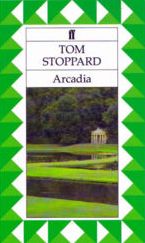Arcadia (play)
| Arcadia | |
|---|---|

Cover of first edition
|
|
| Written by | Tom Stoppard |
| Date premiered | 13 April 1993 |
| Place premiered | Lyttelton Theatre Royal National Theatre London |
| Original language | English |
| Subject | History, science, philosophy, mathematics, love, death |
| Genre | Comedy/drama |
| Setting | A Derbyshire country estate in both the past (1809, 1812) and "the present" |
Arcadia is a 1993 play by Tom Stoppard concerning the relationship between past and present, order and disorder, certainty and uncertainty. It has been praised by many critics as the finest play from one of the most significant contemporary playwrights in the English language. In 2006, the Royal Institution of Great Britain named it one of the best science-related works ever written.
Arcadia is set in Sidley Park, an English country house in Derbyshire, and takes place in both 1809/1812 and the present day (1993 in the original production). The activities of two modern scholars and the house's current residents are juxtaposed with those of the people who lived there in the earlier period.
In 1809, Thomasina Coverly, the daughter of the house, is a precocious teenager with ideas about mathematics, nature and physics well ahead of her time. She studies with her tutor Septimus Hodge, a friend of Lord Byron (an unseen guest in the house). In the present, writer Hannah Jarvis and literature professor Bernard Nightingale converge on the house: she is investigating a hermit who once lived on the grounds; he is researching a mysterious chapter in the life of Byron. As their studies unfold – with the help of Valentine Coverly, a post-graduate student in mathematical biology – the truth about what happened in Thomasina's time is gradually revealed.
The play's set features a large table, used by the characters in both past and present. Props are not removed when the play switches time period; books, coffee mugs, quill pens, portfolios, and laptop computers appear together, blurring past and present. An ancient but still living tortoise also appears in every scene, symbolising long-suffering endurance and the continuity of existence.
The play opens on 10 April 1809, in a garden-front room of the house. Septimus Hodge is trying to distract 13-year-old Thomasina from her curiosity about "carnal embrace" by challenging her to prove Fermat's Last Theorem; he also wants to focus on reading the poem "The Couch of Eros" by Ezra Chater, a guest at the house. Thomasina starts asking why jam mixed in rice pudding can never be unstirred, which leads her on to the topic of determinism and to a beginning theory about chaotic shapes in nature. This is interrupted by Chater himself, who is angry that his wife was caught in the aforementioned "carnal embrace" with Septimus; he has come to demand a duel. Septimus tries to defuse the situation by heaping praise on "The Couch of Eros". The tactic works, because Chater does not know it was Septimus who savaged an earlier work of his, "The Maid of Turkey". Then landscape architect Richard Noakes enters, shortly accompanied by Captain Brice and Lady Croom; the three discuss proposed modifications to the gardens, while Thomasina sketches an imaginary hermit on Noakes's technical drawing of the garden.
...
Wikipedia
